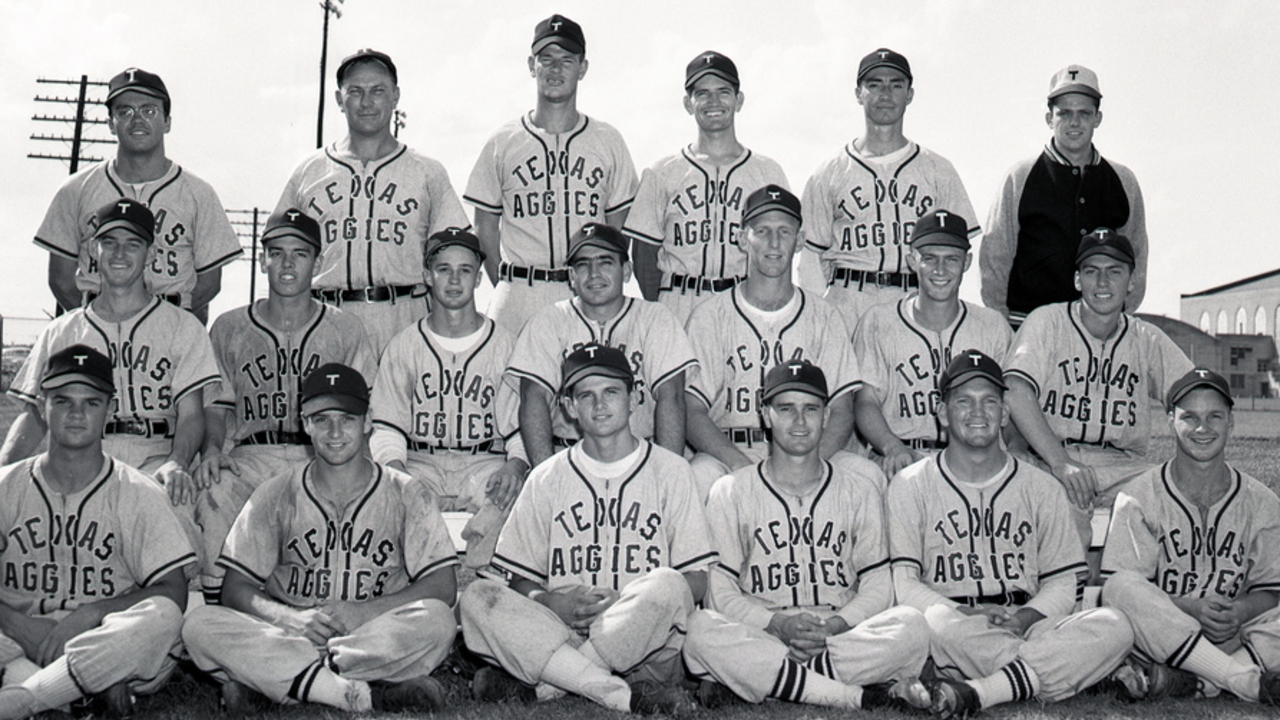
First Aggies in Omaha: Looking back at the 1951 Texas A&M baseball team
EDITOR’S NOTE: This story originally appeared in the spring 2001 edition of 12th Man Magazine, but with the Aggies returning to Omaha, we felt it would be fun to take a trip down memory lane and look back at the 1951 Texas A&M baseball team, which made history as the first College World Series team in school history. The story has been updated, but the quotes remain the same. Based on research, it is believed that all of the players from the 1951 team who are quoted have died in the past 21 years.
In the last 35 years, Texas A&M has made four trips to the College World Series (prior to this season) and come ever-so-close to making numerous other appearances in the CWS. In addition to making it in 1993, 1999, 2011 and 2017, the Aggies were just one win away from Omaha seven other times—1987, 1989, 1992, 1995, 1998, 2015 and 2016.
Just one more regional or super regional win—the format changed in 1999—in any of those seven seasons, and the Aggies would have been in the mix for the national championship. But as former A&M head coach Mark Johnson can attest, simply getting to college baseball’s ultimate destination is one of the toughest challenges in all of collegiate team sports.
“Possibly more than any other sport, baseball is a game where the best team doesn’t always win,” Johnson said. “You can hit the ball extremely well, but it might be right at someone. You may have the great pitching, but a bloop can beat you. There is so much parity in college baseball, which makes getting to the CWS very, very difficult.
“But that does make getting there incredibly rewarding. The times I made it were so exciting and so thrilling that I will never forget a single moment.”
That said, it’s rather amazing to consider how times have changed and how Texas A&M’s first appearance in the College World Series almost didn’t happen. Not because of a near-miss in a regional, but rather, because of a general lack of interest from Texas A&M school officials.
The year was 1951, and the Aggies began Southwest Conference play with a rather pedestrian 3-4 record. But A&M then went on an eight-game winning streak, which included back-to-back wins over defending national champion Texas to close the regular season. The streak gave the Aggies an overall record of 18-8, a share of the SWC title and set up a best-of-three District 6 playoff series against Arizona.
Or so it seemed.
“As I understand it now, the school wasn’t even going to send us to Arizona,” said pitching ace Pat Hubert, who compiled a 12-2 record in 1951. “Arizona was a big-time power. They were (27-2) going into that series against us and were ranked very high.
“We were just 18-8, so there was a feeling from our own officials that, ‘What’s the use of sending these punks out there? It’s just a waste of money.’ But as I understand it now, some of our former students got together and made them send us and contributed to our fare.”
Good move. The heavily underdog Aggies went to Tucson and stunned the Wildcats, winning the third and deciding game, 14-2, to advance to the College World Series.
“Not bad for a group that almost didn’t even get to go to Arizona,” Hubert said. “It was such a thrill. To look back on it now, it’s hard to believe it’s been 50 years. None of us were really what you would call great players, but we became a pretty special group.”
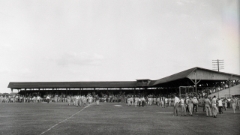
Indeed, the ’51 Aggies were special in every sense of the word. They were eliminated in three games at the College World Series, but just getting to Omaha was a rather incredible accomplishment.
The journey to the CWS included nail-biting wins and white-knuckle flights. It involved some good breaks and great individual performances. Most of all, though, it featured a tremendous team effort—a group of young men who believed so much in each other that the overwhelming obstacles never seemed to come into focus.
“We just had a unique camaraderie,” 1951 second baseman Joe Ecrette said. “We all liked each other and enjoyed playing together. We didn’t have any superstars, but we sure didn’t have any quitters, either. It was just a special team and a bunch of good guys who played great as a team.”
GETTING ON A ROLL
What turned out to be such an extraordinary season didn’t begin so spectacularly. The Aggies’ head coach from 1948-50, Marty Karow, had left A&M for Ohio State following the 1950 season, and the Aggies’ best player from the previous season, Wally Moon, had been drafted by the St. Louis Cardinals.
The ’51 squad featured a relatively no-name roster led by a new head coach who had virtually no coaching experience. R.C. “Beau” Bell was an All-American at A&M in 1931, and he had made the American League All-Star team in 1937 as a member of the St. Louis Browns. He also played professionally with Detroit and Cleveland.
But as far as coaching goes, well, Bell was not exactly a masterful mentor or a charismatic leader. He had just a brief coaching stint in the minors before returning to A&M
“Beau Bell didn’t say a whole lot,” said former A&M catcher Al Ogletree, who coached Pan American to the CWS in 1971. “And he didn’t have much experience as a coach. Guy Wallace and Pat Hubert were our captains, and Beau would ask them what they wanted to do today and whatever they wanted to do, we would do. Play an intra-squad game… hit, take outfield or infield. It was really still Marty’s team.”
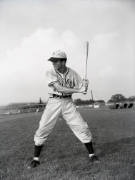
The ’51 Aggies began the year looking like a team without much direction. A&M opened the year by splitting a pair with Brooke Field Medics and was just 6-4 heading into conference play. And league play certainly didn’t begin with many dramatics, as the Aggies were just 3-4 on April 27.
But on the following day against a TCU team that had already beaten A&M twice earlier in the season, something happened that lit a fire under the Aggies.
Playing in Fort Worth, team captain and shortstop Guy Wallace became infuriated by what he perceived as a bad call.
“That’s when Guy Wallace got his name, ‘The Rooster,’” said Ecrette, who together with Wallace formed A&M’s double-play duo. “Rooster got mad at a double play call, and (team manager) Ted Mohle started calling him that because he looked like a little rooster out there. He and I had a double play, and they called the runner safe, and Rooster got right up in (the umpire’s) face and got thrown out of the game.
“Jim Dishman came in and played the rest of the game at shortstop, but anyway, we kind of got fired up. From then on we just started winning and winning and winning. We weren’t thinking about Omaha. We weren’t thinking about anything but the next game. But before we really knew it, we came down to that last series against Texas with a chance to tie for the conference crown.”
To do that, however, the Aggies would have to beat Texas in back-to-back games at rickety ol’ Kyle Field, which backed up to the west stands of the Aggies’ home football stadium. Earlier in the season, Texas had hammered out a 14-10 win over A&M in Austin.
The Longhorns were also a pressure-tested bunch, as UT had won national championships in 1949 and ’50—the first two years the College World Series was played in Omaha’s Rosenblatt Stadium.
Texas was so confident that it would come into College Station and win at least one game that UT head coach Bibb Falk announced he would waive all NCAA rights—including a possible one-game playoff between A&M and Texas—if the Aggies swept the two-game series.
“Maybe there should have been a lot of pressure on us going into that series, but I really don’t think we felt it at all,” said former A&M outfielder Bill “Shug” McPherson. “We weren’t thinking about Omaha or getting to the District playoffs or anything of the sort. We just wanted to beat Texas.”
Mission accomplished. Behind the pitching of Hubert, the Aggies beat the Longhorns 4-2 on May 17 to set up a winner-take-all showdown on May 18.
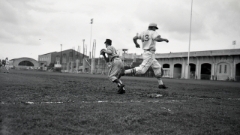
Texas still sensed it was in control, but the Aggies believed much differently. After all, A&M was sending its Longhorn killer to the hill on the final day of the regular season. Bob Tankersley’s overall numbers weren’t particularly dazzling, but he certainly had a knack for dazing the Longhorns.
Including his freshman season at A&M, Tankersley beat Texas six times in four years. None was more important or satisfying than the regular-season finale in 1951.
“We had to win it,” said Tankersley, who went 6-4 in 1951. “We felt good about our chances, too. I believed I could beat Texas here, there, in the heat or snow. I think I had their number. As a matter of fact, I believe I could still beat them tomorrow.”
Tankersley certainly did his part, allowing just five hits and only a solo home run in the ninth, as the Aggies hammered out a 4-1 win. During one particularly impressive stretch, Tankersley retired 13 consecutive Longhorn batters.
To that point, it was the greatest day of the season for the Aggies. And it was certainly the start of the most memorable weekend in Joe Ecrette’s life. Ecrette went 2-for-4 against the Longhorns that afternoon, had a bachelor party that night and got married the next day. It wasn’t until he picked up the newspaper the day after his wedding that he realized he needed to get back to College Station.
“I read the next day that I had to be back at A&M because we were going to Tucson to play Arizona,” said Ecrette, who celebrated his 50th wedding anniversary to Wanda Ecrette on May 19, 2001. “I drove right back. Actually, my wife of two days drove back, and I left her there, and I went to Tucson with the team. Like I said, we weren’t thinking of anything but beating Texas. Everything after that was just gravy.”
RAZING ARIZONA
Once it was finally determined the Aggies would indeed face Border Conference champion Arizona in the District 6 playoffs—and that A&M officials would actually send the Aggies there—18 A&M players boarded a plane for a memorable flight and an even more unforgettable realization in Tucson.
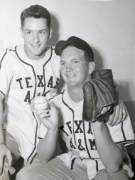
“That was kind of a white-knuckle flight for a lot of us, and it was probably the first time to fly for some of us,” said Ogletree, who would go on to spend 41 years in coaching and 44 in teaching. “The plane was real old and full of flies. It was hot in there, too. We ran through a rain storm, and we didn’t know if we were going to make it or not. It certainly wasn’t first class.”
Neither were the accommodations. Upon arriving in Tucson, the Aggies discovered that they would be staying in rather uncomfortable surroundings.
“It wasn’t even a roach motel,” said Hubert, who served as a veterinarian for more than 50 years in Kingsville. “It was the stinkin’ equipment room under the cotton pickin’ football stadium. And, of course, in the latter part of May, it’s incredibly hot in Arizona. It was a wide-open space that wasn’t even enclosed. They just through a bunch of Army cots in there for us to sleep on. We also had to walk a half a mile to the cafeteria to eat. Arizona really thought a lot of us. They really took care of us—about like you might take care of a stray dog.”
No matter, Bell reminded his team. The Aggies were in Tucson to play baseball, not vacation. And before a crowd of 1,200 fans at Arizona’s University Diamond on May 23, A&M seemed to be on top of its game.
With Hubert on the mound and solid defense behind him, the Aggies carried a 3-2 lead into the sixth inning. But Hubert made two mistakes the rest of the way, as Arizona hit solo homers in the bottom of the sixth and eighth inning to take a 4-3 lead into the ninth.
“I couldn’t believe I had given up the lead,” Hubert said. “Then in the top of the ninth, things were looking pretty bleak.”
Yale Lary actually opened the Aggies’ ninth with a single and was at third with two outs and Henry “Yogi” Candelari coming to the plate. Candelari then popped the ball up in the infield, as Arizona shortstop Ron Nicely circled under it to apparently record the final out of the game.
Fans were literally leaving the stadium as the ball hit Nicely’s glove. But before he could secure it, the ball popped out. Lary trotted home with the tying run and Candelari ended up at second on the error.
“It was the durndest thing I had ever seen,” McPherson said. “Yogi hits the pop-up, and we all figure the game is over. I guess (Nicely) lost it in the sun or something. Whatever the case, he dropped it and gave us another chance.”
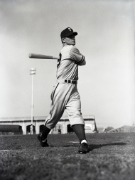
The next A&M batter was Ogletree, who promptly laced a double into the gap to score Candelari with what proved to be the game-winning run. Arizona put two men on base in the bottom of the ninth, but Hubert struck out the final two Wildcats to register an improbable 5-4 win.
“Once we got the lead, I told Beau, ‘Coach, they ain’t going to score. I guarantee you that if there’s anybody I want to beat, for putting us over where they did and for being so cocky, it’s this bunch,’” Hubert said. “The shortstop (Nicely) had told my roommate, John DeWitt, ‘You damn Texans are going home tomorrow night.’ Well, he turns out to be the guy who drops the pop-fly that allowed us to win the game.”
Luck did not smile on the Aggies the following game, however. A&M allowed 15 walks and committed seven errors in a 21-4 loss to the Wildcats on May 24 to even the series at 1-1. So, what happened to the Aggies?
“To tell you the truth,” said Tankersley, who started the second game, “That was a night game, and we just weren’t used to playing at night. We proved that right away. We had some bad, bad errors and walks. It just snowballed on us. Fortunately, the first and last games of that series were in the afternoon.”
In Game 3, Wallace, Ecrette, Candelari and Hollis Baker each collected two hits as A&M built a 9-0 lead after three innings and coasted to a 14-2 win. On the mound, Hubert was simply dazzling, allowing the Wildcats just six hits and two runs. Entering the A&M series, Arizona had been averaging 11 runs per game.
With the victory, the Aggies earned their first trip to the College World Series. No one on the roster, however, really knew what a big accomplishment it was at the time.
“That’s where everyone wanted to go,” Ogletree said. “We knew that it was a big deal, but I’m not sure anyone really knew how big of a deal it was. The College World Series wasn’t very old; it was fairly new to everyone. The only thing we really knew was that Texas had won that thing the year before, and we wanted to top Texas.”
NIGHTFALL IN OMAHA
Unlike their trip to Tucson, the Aggies were treated to some outstanding accommodations in Omaha. But like the trip to Arizona, A&M was not at the top of its game when the sun went down.
Playing Springfield (Mass) College in the opening game of the CWS, the Aggies were viewed as heavy favorites. In fact, A&M and USC were perceived as the favorites to win the entire tournament. After all, the Aggies came out of the Southwest Conference, which had produced the last two national champions.
“We went in there thinking that we were going to win the whole thing,” Hubert said. “And to this day, I think if we would have played (Springfield) in the day, we would have won that game. Then, who knows?”
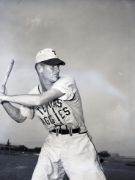
Instead, the Aggies played Springfield at 8:30 p.m., and it was lights out for A&M. The Aggies managed just three hits against Springfield in a 5-1 loss. But falling into the loser’s bracket set up an interesting second-round game against Ohio State and former A&M head coach Marty Karow.
In the sunlight, the Aggies proved to be too much for the Buckeyes, as Tankersley pitched a gem and Lary hit the game-winning homer in a 3-2 victory.
“It was pretty sweet to beat Karow there in Omaha,” Ecrette said. “He had been our coach the year before, and we all wanted to prove to him that we were the better team. Plus, we believed that we were back on a roll.”
In the third game of the CWS, Texas A&M rolled to a big lead over Utah in the early innings. But once again, nightfall seemed to get the best of the Aggies. The early A&M lead was built at twilight of the 6 p.m. start. But as the sun set, the Aggies watched Utah rally for a 15-8 win.
“We were very upset. Utah beat us, and they weren’t as good as Ohio State, and we had handled Ohio State,” Hubert said. “But it ended right there. It’s too bad because we thought we could have handled anybody out there.”
As it turned out, Oklahoma went on to win the 1951 national championship, beating Tennessee 3-2 in the title game. And Texas A&M would not make another College World Series appearance until Tom Chandler returned the Aggies to Omaha in 1964.
By that time, the ’51 Aggies realized what an impressive accomplishment they had achieved simply by reaching Omaha.
“Once I got into coaching, I realized how much we had accomplished by simply getting to the College World Series and how much it takes just to get there,” Ogletree said. “It takes some breaks, and we got some in ’51. But it also takes a pretty remarkable group of guys, and I think it’s pretty evident that we had that, too.
“Even at our 50-year reunion, which we had (in April 2001) back in College Station, you can still look around at all of the guys and realize it was a pretty special group. Most all of the guys are still alive, and most of them have lived a very fulfilling and successful life. It was just a special team—a very special team.”

